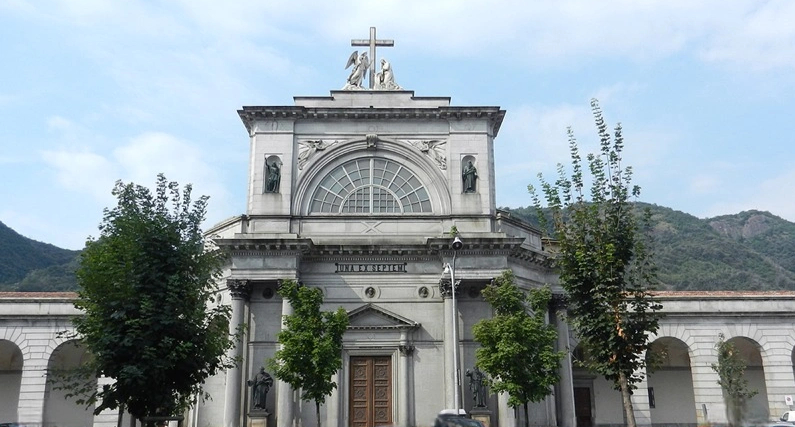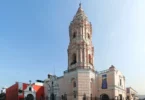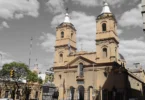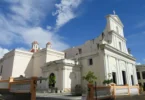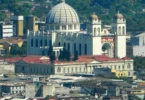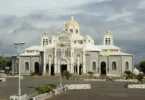Introduction
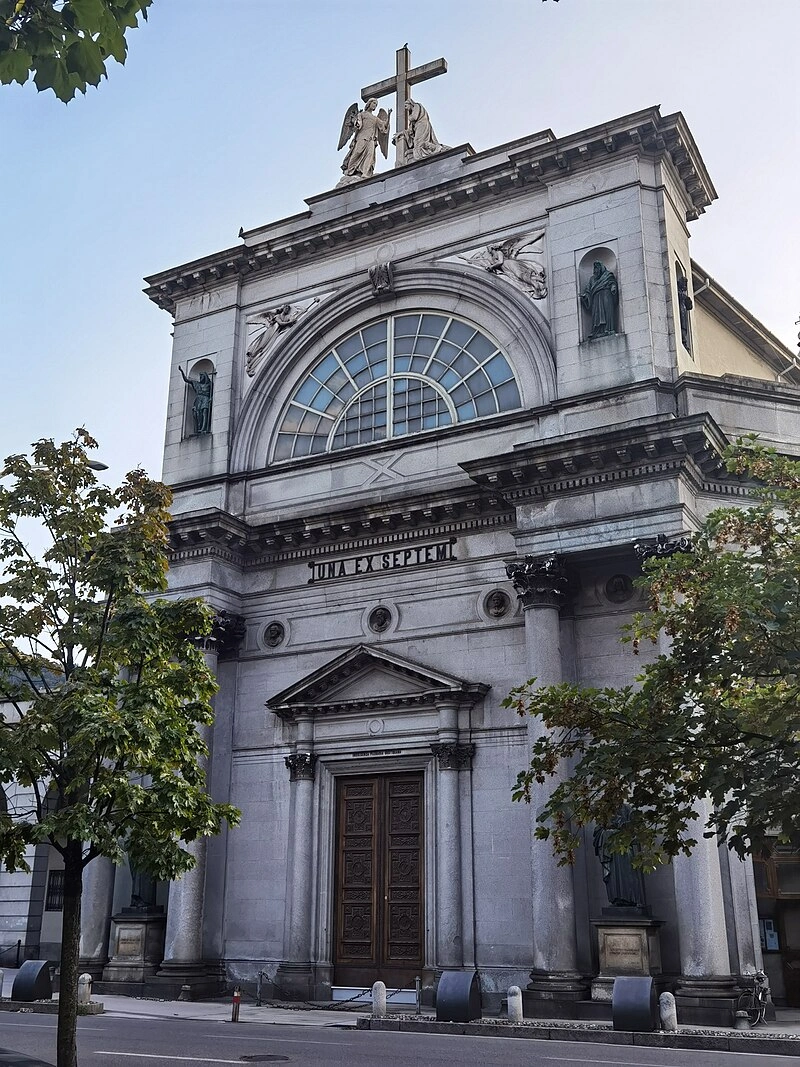
The Sanctuary of the Holy Crucifix, officially known as the Sanctuary of the Holy Crucifix of the Annunciation, is a prominent Catholic place of worship located in the city of Como, Italy. Recognized as one of the votive sanctuaries and temples within the Diocese of Como, it holds significant historical, religious, and cultural importance. Dedicated to Santa Maria Annunciata (Our Lady of the Annunciation), the sanctuary is the second largest church in Como, following the Cathedral of Como, and is considered one of the city’s most revered spiritual landmarks. At the heart of its religious significance is a wooden crucifix that has been venerated for centuries. According to tradition, this crucifix is linked to a miraculous event that took place in 1529, which elevated the sanctuary to a focal point of local devotion. The Sanctuary remains especially central to the spiritual life of the city during Holy Week, when the faithful gather in large numbers to honor the crucifix and participate in solemn celebrations. Its rich history, architectural grandeur, and role in communal devotion make it a vital part of Como’s religious heritage.
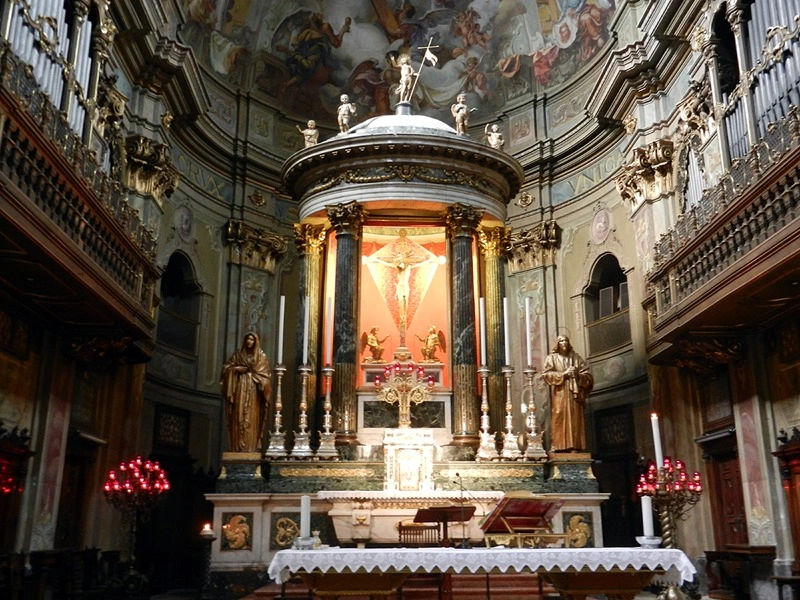
Origins of the Sanctuary
The earliest recorded foundation of a church on the site of the present-day sanctuary dates back to 1236, traditionally attributed to Canon Erasmo Campacci, who initiated the reclamation of this once-marshy land located just outside the medieval city walls of Como. However, other historical sources suggest alternate dates for the church’s origin, such as 1331 or 1336, reflecting varying interpretations of its early history. The first structure was a small church dedicated to Santa Maria Annunciata (Our Lady of the Annunciation), a devotion that would remain central to the sanctuary’s identity throughout the centuries.
The Gift of the Holy Crucifix (1401)
A pivotal moment in the sanctuary’s history occurred in 1401, when the church, then under the care of Celestine monks, received a remarkable gift: a wooden crucifix brought by a group of pilgrims, likely of French origin, who were returning from the Jubilee Year in Rome proclaimed by Pope Boniface IX in 1400. This crucifix quickly gained veneration within the Diocese of Como, becoming a central object of devotion. It was soon incorporated into Holy Thursday processions, carried solemnly through the streets of Como, reinforcing the sanctuary’s spiritual importance in the region.
The 1529 Miracle
The sanctuary’s fame grew significantly due to a miraculous event said to have occurred on March 25, 1529, during the annual Holy Thursday procession. According to tradition, as the crucifix was being carried through the city, the route to the Church of San Bartolomeo was blocked by two iron chains—part of a military defense set up by the Spanish governor to guard against potential French cavalry raids from nearby Milan. In what witnesses described as a miracle, the crucifix broke free the chains from the walls to which they were fastened. The event was immediately recognized by those present as divine intervention. In 1608, the Catholic Church officially acknowledged the miracle, solidifying the sanctuary’s status as a site of special grace and spiritual power. This miraculous act became the foundation of widespread devotion to the crucifix, which extended beyond Como to neighboring areas, including the Canton of Ticino in Switzerland.
Architectural Evolution
16th to 17th Century Developments
By the mid-1500s, the church had a single nave, with the miraculous crucifix enshrined in the left altar. In 1565, the original building—then in poor condition—underwent significant reconstruction. The church was enlarged and reconsecrated in 1574, with Saint Peter Celestine added as co-patron, reflecting the influence of the Celestine Order, which had administered the site. In 1625, a major restructuring was undertaken. The sanctuary’s façade was reoriented to face the city, symbolically opening it more fully to the people. Father Angelo Bianco, the parish priest of nearby Piazza Santo Stefano, led the redesign. Domenico and Antonio Cassina, also from Santo Stefano, oversaw the construction of the presbytery in 1629. By 1630, new chapels had been added—one dedicated to the Crucifix, the other to the Immaculate Conception. Following the suppression of the Celestine monastery in 1654, the site was established as the Parish of the SS. Annunciata, though the title of “prior” for its clergy remained in homage to its monastic past.
18th Century Expansions
With an increasing influx of devotees, further expansion took place in the 18th century. Between 1716 and 1731, a new Baroque façade was constructed, designed by Carlo Francesco Silva from Morbio. A bell tower, first planned by Francesco Brachetto in 1694, was also completed. Interior renovations followed a plan by Antonio Nolfi and Giulio Galliori in 1761, which included the addition of a transept terminating in three apses, giving the sanctuary its more complex architectural form.
19th-Century Restorations and Enhancements
The 1800s brought further modifications. In 1824, architect Luigi Canonica proposed an update that added a tympanum with pinnacles to the façade. A more substantial redesign came in 1863–1864, when Luigi Fontana created the current façade and porticoes that now define the sanctuary’s exterior appearance. Between 1845 and 1853, the nave was raised under the guidance of Luigi Tatti, allowing more space and enhancing the visual impact of the interior space.
20th Century and Papal Recognition
In 1893, the Clerics Regular of Somasca (Somaschi Fathers) assumed responsibility for the sanctuary’s pastoral care. Just a few years later, in 1901, during the celebration of the 500th anniversary of the crucifix’s arrival, Pope Leo XIII granted the church the prestigious title of Minor Basilica. It was also officially affiliated with the Archbasilica of St. John Lateran in Rome.
San Probino’s Relics (1933)
In 1933, the sanctuary was further enriched with the relics of Saint Probino, a revered local saint. These relics were transferred from the former Church of San Provino, enhancing the sanctuary’s sacred significance and making it a site of even deeper pilgrimage.
Architecture of Sanctuary of the Most Holy Crucifix of the Annunciation, Como, Italy
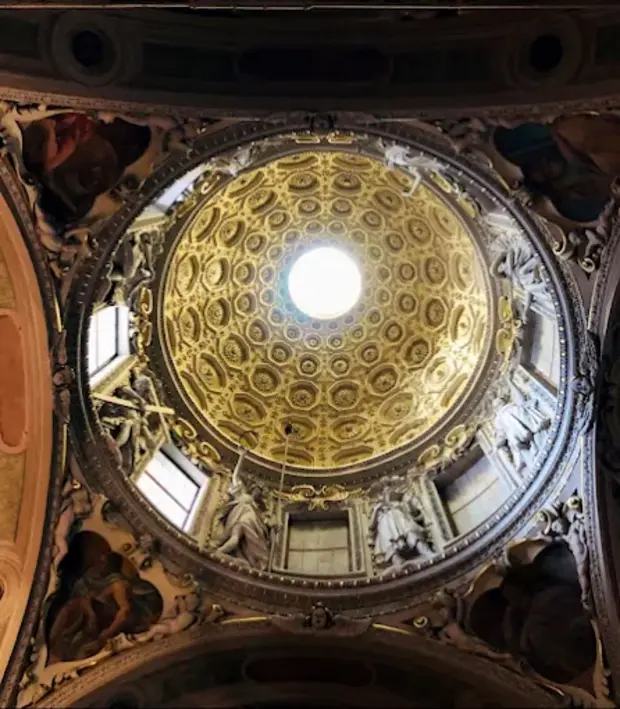
Architectural style : Neoclassicism architecture, Neo-Baroque architecture.
Exterior Architecture
The exterior of the Sanctuary presents a grand and harmonious composition in late Neoclassical style, finalized in the 19th century. The central façade, elegant and symmetrical, is enhanced by sculptural decorations and bronze artworks that emphasize its religious significance. Flanking the main entrance are two imposing bronze statues of Saints Peter and Paul, crafted between 1932 and 1934 by sculptor Giuseppe Siccardi. Above the entrance, a large semicircular window is framed by four additional bronze statues—two angels by Pietro Bernasconi (1865) and figures of John the Baptist, Zechariah, Joachim, and Anna sculpted by Siccardi in 1934.
At the very top of the façade, a beautiful sculptural representation of the Annunciation—carved from Carrara marble by Giuseppe Bayer in 1871—honors the sanctuary’s full title. The building’s monumental presence is further accentuated by two large porticoes on its flanks: the southern portico designed by Luigi Fontana in 1863 and the northern one attributed to Luigi Canonica. A prominent Baroque bell tower, built between 1761 and 1785, houses five bronze bells cast in 1909, completing the sanctuary’s majestic skyline.
Interior Layout and Artistic Elements
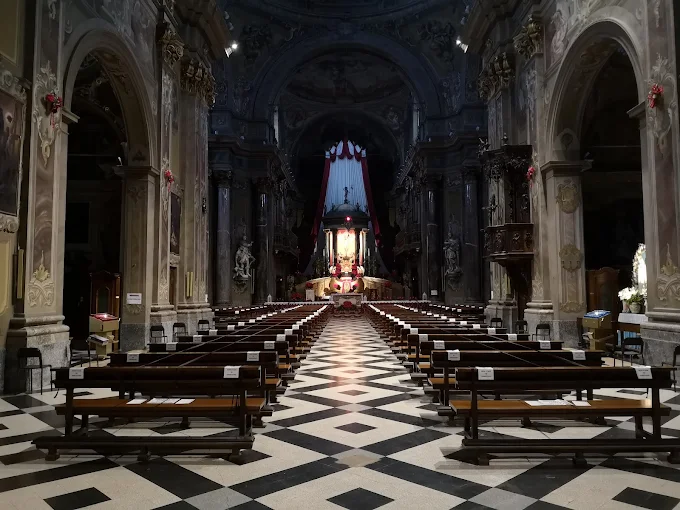
Inside, the sanctuary is a richly decorated space shaped by centuries of renovations and stylistic transformations. The central nave, measuring 41 meters in length, follows the original axis of the church, which was initially oriented in the opposite direction. The nave is a single broad aisle flanked by chapels and covered with neo-Baroque frescoes, featuring statues of biblical kings and prophets sculpted by Stefano Salterio in the 18th century. Two Baroque-style wooden organs, built in 1679–80 and 1807–08, are integrated into the presbytery, emphasizing the church’s longstanding musical tradition. The overall interior merges various artistic periods while maintaining a coherent devotional atmosphere.
Gallery of Miracles
On the southern side of the sanctuary lies the Gallery of Miracles, a long corridor preserving more than 400 votive offerings donated by the faithful over the centuries in gratitude for perceived divine favors. These ex-votos span various eras, although many silver offerings were lost during Napoleon’s secularization of church assets. One of the most significant pieces in the gallery is a large painting depicting the 1529 miracle—the moment when the Crucifix broke the chains during the Holy Thursday procession. The artwork was restored in 1790, preserving this foundational legend of the sanctuary.
Chapel of the Pietà and Ossuary
The Chapel of the Pietà, located at the southern portico entrance, serves as both a commemorative and funerary space. Originally the site of a small cemetery, it was converted into a baroque ossuary in 1636 during the plague epidemic. Today, it contains a sculpture of the Pietà set above a collection of visible human skulls, offering a powerful symbol of remembrance and mortality. This space commemorates the victims of the 1630 plague and reflects the sanctuary’s role as a place of both devotion and community memory.
Chapels of the Nave
Along the nave, there are four chapels, each distinct in its artistic expression. On the right side, the Chapel of the Immaculate Conception stands out for its vibrant frescoes and statuary. It features works by Carlo Innocenzo Carloni and quadraturists Domenico Dobler and Carlo Giuseppe de Vincenti, dating to 1725–1726. Scenes include the Nativity of the Virgin and the Presentation of the Virgin in the Temple. The chapel also holds stuccoes by Diego Carloni and a reworked statue of Saint Margaret, originally sculpted in 1666 by Giovan Battista Bianchi. On the left side, the Chapel of the Sacred Heart of Jesus once housed the sanctuary’s revered crucifix. This chapel includes an altarpiece by Carlo Buzzi (1638–1649) and is decorated with statues by Francesco Silva, stuccoes by Francesco Sala, Francesco Rusca, and Gian Battista Barberini, and frescoes by Giovanni Paolo Recchi and Pier Francesco Mazzucchelli. Some of the decorations were restored in 1856 by Andrea Fleissner, and further works by the Recchi brothers are preserved in the sacristy.
Additional Chapels and Decorations
Among the smaller chapels, the one dedicated to Saint Gerolamo Emiliani is adorned with paintings by Gersam Turri, while the baptismal chapel on the opposite side features a fresco by Onorato Andina, completed in 1870. These chapels contribute to the sanctuary’s spiritual diversity and artistic richness.
Dome and Transept
At the crossing of the nave and transept rises a magnificent dome, supported by eight massive columns. Painted by Gersam Turri in 1929, the dome’s frescoes portray the royalty of Christ, reinforcing His divine kingship. Standing in front of the columns are four monumental statues sculpted by Stefano Salterio around 1785, representing biblical leaders and kings: David, Solomon, Moses, and Joshua. Crafted in polished stucco, these figures embody the sanctuary’s message of faith, leadership, and divine providence.
Presbytery Area
The presbytery, located at the eastern end of the nave, concludes in a semi-circular apse, the vault of which is richly decorated with frescoes by Mario Albertella. These works add color and spiritual depth to the sanctuary’s liturgical heart. Albertella is also credited with the frescoes that adorn the smaller domes within the church, including the dome directly above the presbytery, harmonizing the interior with vibrant religious imagery. On the walls along the nave, a complete series of the Stations of the Cross (Via Crucis) is displayed, each panel painted by Ponziano Loverini, contributing to the spiritual atmosphere of prayer and reflection, especially during Lent and Holy Week.
To the right of the main altar, a noteworthy painting of the Martyrdom of Saint Lawrence is preserved. This work, created by Panfilio Nuvolone, originally belonged to the now-suppressed Monastery of San Lorenzo. It was once positioned in the left altar, which is now occupied by a statue of Saint Joseph, sculpted by Cappelletti, demonstrating the evolving arrangement of sacred art within the sanctuary. On either side of the main altar stands the historic Serassi organ, constructed in 1808. This majestic instrument, with its 3,119 pipes, is a significant piece of Como’s musical and liturgical heritage, though it is currently no longer functional. Also of historical interest is the 17th–18th century processional banner of the Confraternity of the Annunciation, once used to accompany the Crucifix during Easter processions, now carefully preserved within the sanctuary.
The Holy Crucifix: Placement and Devotion
At the heart of the sanctuary’s devotion lies the revered Holy Crucifix, housed immediately behind the main altar in a dedicated neoclassical temple structure. This elegant shrine, designed by Tomaso Malaspina in 1815, frames and elevates the Crucifix, allowing the faithful to venerate it in solemn reverence. The small temple is flanked by bronze sculptures by Giuseppe Siccardi, further enriching its symbolic presence. The Crucifix itself is a 128 cm tall sculpture carved in cypress wood, believed to date back to the late 14th or possibly late 15th century, and is of likely French origin. The figure of Christ is notably lifelike, featuring real human hair and beard, as well as reclining arms and a tilted head, emphasizing the suffering and humanity of the Savior. The current silvered wooden cross, crafted in the 18th century, replaced an earlier support known as the “Cross of the Miracle”, which is still preserved in a niche near the left side entrance.
Devotional Practices and Holy Week Traditions
The Holy Crucifix has long been the object of profound devotion in the Como region. Each year during Holy Week, the sacred image is adorned with medals of valor donated by war veterans. It is elevated on a special platform designed to evoke Mount Calvary, where the faithful line up to kiss the feet of the Crucifix, in a time-honored gesture of humility and reverence. This ritual is among the most deeply rooted traditions in the Diocese of Como and holds immense cultural and spiritual importance. On Good Friday, the Crucifix is solemnly carried in procession through the streets of Como, led by the Bishop and attended by large crowds of citizens and pilgrims. This emotional event often disrupts city traffic due to the high number of participants, reflecting the depth of communal attachment to the miraculous image.
Miracle of World War II and the Day of Gratitude
Beyond its foundational miracle in 1529, the Crucifix is also linked to a second, unofficial miracle during World War II. In January 1943, amidst fears of Allied bombings, the Crucifix was carried in an extraordinary procession through the city. Remarkably, Como was spared significant destruction during the war, an outcome that many citizens interpreted as divine protection attributed to their devotion. In gratitude, the people of Como commissioned a royal diadem as an ex voto offering. On 17 June 1945, Cardinal Ildefonso Schuster, Archbishop of Milan, crowned the Crucifix, an act symbolizing the community’s faith and thankfulness. This legacy of protection is honored annually with the “Day of Gratitude”, held on 14 September, during which the faithful, city authorities, and the Bishop of Como gather to renew their vows of thanks and devotion to the miraculous Crucifix. This celebration is a cherished moment of reflection and unity for the entire city.
Feast Day
Feast Day : 25 March
The feast day of the Most Holy Crucifix at the Sanctuary of the Most Holy Crucifix of the Annunciation in Como, Italy, is celebrated on Good Friday, marking the 1529 miracle when the crucifix reportedly broke chains during a procession. The Feast of the Annunciation is celebrated on March 25th, honoring the angel Gabriel’s announcement to the Virgin Mary.
Church Mass Timing
Monday to Friday : 7.00 am – 8.00 am, – 11.00 am – 6.00 pm.
Saturday : 6.00 pm.
Sunday : 8.30 am – 10.00 am, – 11.30 am – 6.00 pm.
Church Opening Time:
Monday to Sunday : 7.00 am – 12.00 pm, – 3.00 pm – 7.00 pm.
Contact Info
Address : Sanctuary of the Most Holy Crucifix of the Annunciation
Viale Varese, 23, 22100 Como CO, Italy
Phone : +39 031 265180
Accommodations
Connectivities
Airway
Sanctuary of the Most Holy Crucifix of the Annunciation, Como, Italy, to Aeroporto “Ferrarin” Venegono Inferiore, distance between 39 min (26.6 km) via A59.
Railway
Sanctuary of the Most Holy Crucifix of the Annunciation, Como, Italy, to Arcisate Railway Station, distance between 43 min (30.0 km) via SP20.

